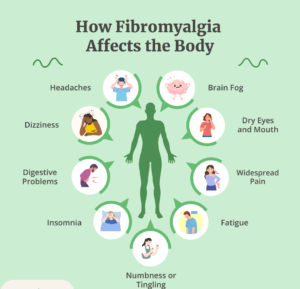Chronic pain is an invisible battle, one that affects millions of people worldwide. Conditions like fibromyalgia, chronic back pain, and other persistent ailments can make daily activities a challenge. But the good news is that there are strategies and treatments available that can help manage the discomfort and improve your quality of life.
Understanding Chronic Pain
Chronic pain is defined as pain that lasts for more than three to six months. It can range from mild to severe and may persist even after the original injury or condition has healed. For conditions like fibromyalgia, the pain isn’t linked to a specific injury but is instead believed to result from how the brain processes pain signals.
Common Types of Chronic Pain
- Fibromyalgia: Characterized by widespread musculoskeletal pain, fatigue, and cognitive difficulties.
- Back Pain: A leading cause of disability worldwide, often due to injury, poor posture, or degenerative conditions.
- Arthritis: Pain and stiffness in the joints caused by inflammation or wear and tear.
- Neuropathic Pain: Stemming from nerve damage, this pain can feel like burning, tingling, or shooting sensations.
Strategies for Relief
Managing chronic pain requires a multifaceted approach. Here are some evidence-based strategies:
1. Medications
- Over-the-counter pain relievers (e.g., ibuprofen, acetaminophen).
- Prescription medications such as antidepressants or anticonvulsants for nerve pain.
- Topical treatments like creams or patches with menthol, lidocaine, or capsaicin.
2. Physical Therapy
- Tailored exercises can improve strength, flexibility, and posture.
- Techniques such as hydrotherapy or massage therapy can reduce tension and improve circulation.
3. Mind-Body Techniques
- Meditation and Mindfulness: These practices help reduce stress and shift focus away from pain.
- Yoga and Tai Chi: Gentle movements can improve flexibility and reduce pain perception.
4. Lifestyle Adjustments
- Maintain a healthy diet rich in anti-inflammatory foods, like leafy greens, nuts, and fatty fish.
- Prioritize sleep to allow your body to repair and recover.
- Stay active but pace yourself to avoid overexertion.
5. Alternative Therapies
- Acupuncture: Stimulates specific points on the body to reduce pain and promote healing.
- Chiropractic Care: Realignment of the spine to alleviate pain and improve function.
- Herbal Supplements: Turmeric, ginger, and omega-3 fatty acids have anti-inflammatory properties. Read more about natural remedies and their benefits.
6. Support Networks
- Join support groups where you can share experiences and gain advice from others facing similar challenges.
- Seek counseling or cognitive-behavioral therapy (CBT) to address emotional aspects of chronic pain.
The Role of a Multidisciplinary Approach
Chronic pain often benefits from a team of healthcare providers working together. A pain management specialist, physical therapist, mental health professional, and nutritionist can collectively create a comprehensive plan tailored to your needs.
When to Seek Help
If chronic pain interferes with your daily life, it’s essential to consult a healthcare provider. Persistent pain is not something you should endure alone—professional guidance can make a significant difference.
Final Thoughts
Living with chronic pain can be overwhelming, but with the right strategies and support, it’s possible to reclaim your life. Be patient with yourself as you explore what works best, and remember, small changes can lead to big improvements over time. Your journey to relief is unique, and every step forward is a victory.

